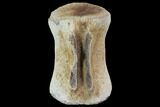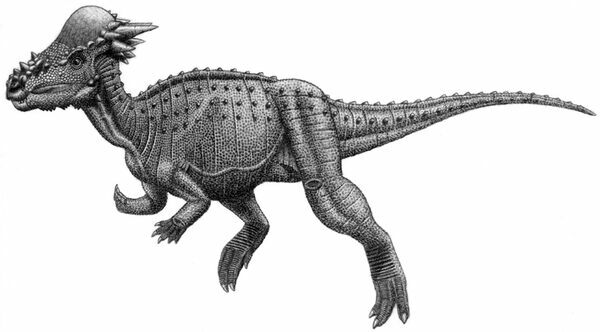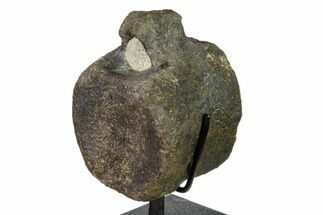This Specimen has been sold.
1.6" Pachycephalosaurus Caudal Vertebra - Montana
This is a 1.6" caudal (tail) vertebra of a Pachycephalosaurus ("thick headed lizard") from the Hell Creek Formation, Glendive, Montana. This vertebrae is well preserved and shows a portion of the spinal foramen.
Pachycephalosaurus was a medium-sized herbivorous bipedal dinosaur from the Late Cretaceous in North America, most notably in the Hell Creek Formation. Pachycephalosaurus is a genus that has had much controversy taxonomically. The two contemporaneous genera Stygimoloch and Dracorex have undergone much scrutiny to determine whether they are valid species or if they are actually juvenile growth stages of Pachycephalosaurus. Most current consensus suggests that they are, making Pachycephalosaurus the predominant Pachycephalosaur of the Hell Creek Formation.
Pachycephalosaurus was a bipedal dinosaur that lived during the Late Cretaceous period and probably was about 15 feet in length.
Pachycephalosaurus had a distinctive large, bony dome on top of its skull up to 10 inches thick to cushion its brain from impacts.
Some paleontologists believe this thick skull may have been used for head-butting, much like modern rams, while others contend it may have been a sexual display.
It was one of the last non-avian dinosaurs before the K-T extinction event, 65 million years ago.
There is only one known species of Pachycephalosaurus, Pachycephalosaurus wyomingensis. Its remains have been found in Montana, South Dakota, and Wyoming.
It was either an herbivore or omnivore with small leaf-shaped teeth effective for shredding plants.
SPECIES
Pachycephalosaurus
LOCATION
Glendive, Montana
FORMATION
Hell Creek Formation
SIZE
1.6 x 1.1"
CATEGORY
SUB CATEGORY
ITEM
#100981
We guarantee the authenticity of all of our specimens.
 Reviews
Reviews















